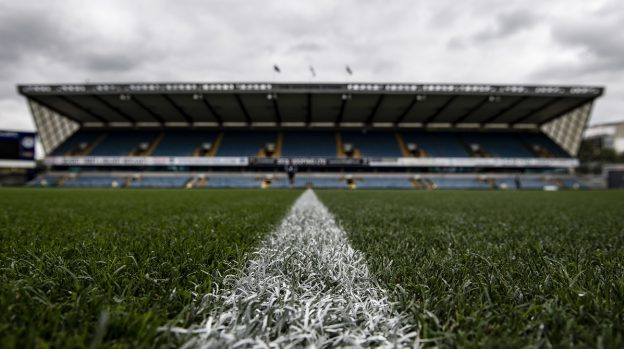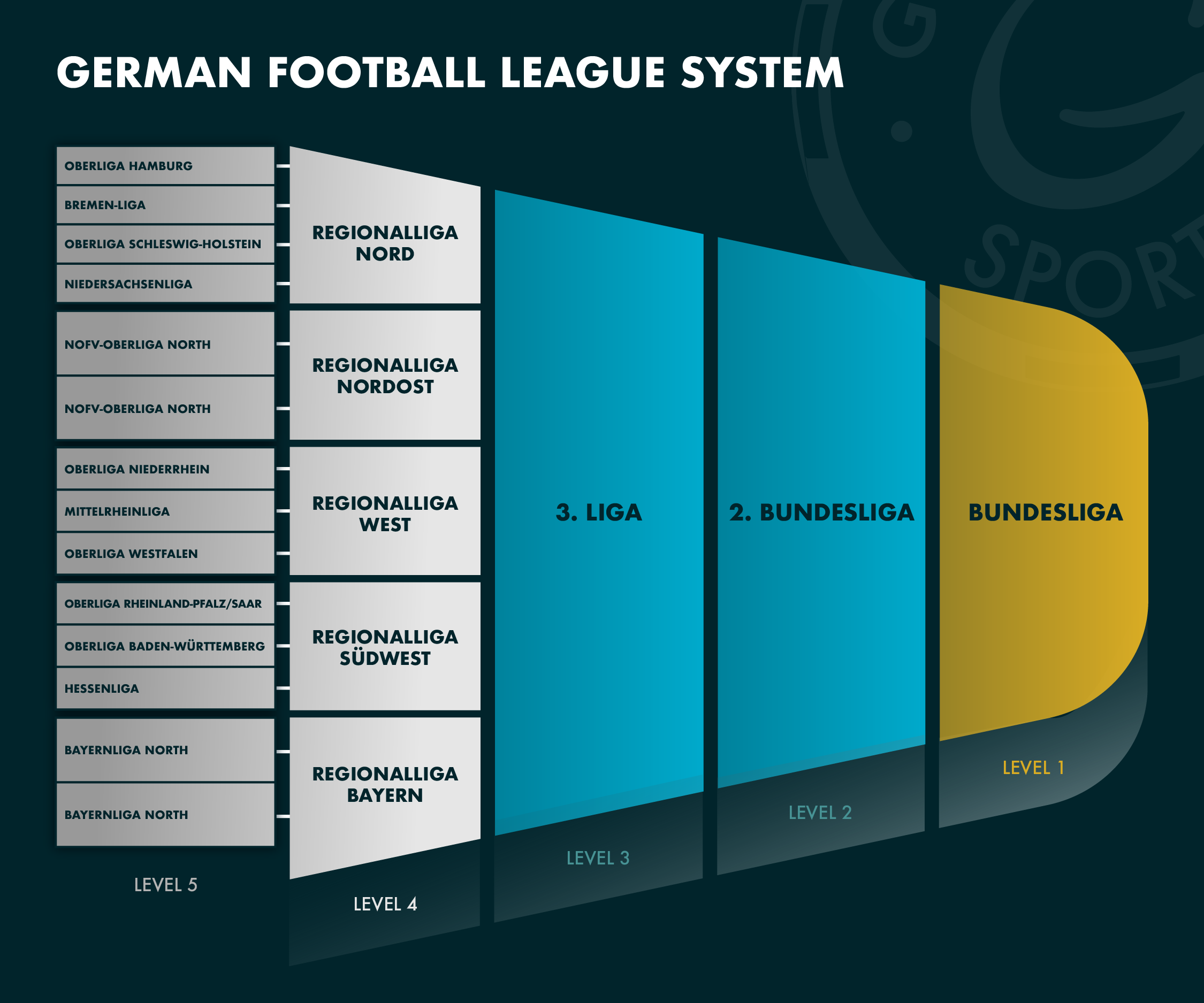The German football league pyramid is one of the most expansive and competitive league systems in world football.
The series of interconnected leagues are run in a hierarchical system with promotion and relegation in place across every division. Much like in the English football leagues, it is this lingering threat of relegation and the tantalising proposition of promotion that ultimately provides the excitement for fans and neutrals alike.
It also gives every side the incentive that one day they could potentially play in Germany’s top league – the Bundesliga.
You can find all our German football odds on our website.
Throughout this guide, we take an in-depth look at the system and how the German football leagues are run.
Our help guide is also on hand if you are new to sports betting.
Level 1: Bundesliga
Number of teams: 18
Teams: RB Leipzig, Borussia Monchengladbach, Bayern Munich, Borussia Dortmund, FC Schalke 04, Bayer 04 Leverkusen, 1899 Hoffenheim, SC Freiburg, VfL Wolfsburg, FC Augsburg, 1. FC Union Berlin, Hertha Berlin, Eintracht Frankfurt, Mainz 05, 1. FC Koln, Fortuna Dusseldorf, Werder Bremen, SC Paderborn 07.
Unlike the Spanish league system, Germany’s highest level the Bundesliga hosts just 18 teams in total, with every side playing each other home and away. The top team is crowned the Bundesliga champions, with the bottom-two sides being relegated. The third-bottom side are entered into a play-off round, where they face the third-placed team from the second tier, the 2. Bundesliga, with the winner sealing the final Bundesliga spot for the following season.
Facts:
- Bayern Munich have won the most Bundesliga titles with 28
- Incredibly, a total of six Bundesliga teams have spent time at the top of the table and also been relegated during the same season
- Cologne striker Dieter Muller famously scored six goals in a single match against Werder Bremen, the only player to do so in the Bundesliga. No player has ever done this in the Premier League.
- German football prides itself on producing young players, with around 60% of Bundesliga players being German, compared to around just 33% of Premier League players that are English.
- In the first year Bayern Munich’s Allianz Arena was open, 700,000 sausages were consumed in total.
Level 2: 2. Bundesliga
Number of teams: 18
Teams: Arminia, Hamburger SV, VfB Stuttgart, Heidenheim, Erzebirge, Vfl Osnabruck, Jahn Regensburg, Furth, SV Sandhausen, Holstein Kiel, FC St. Pauli, Darmstadt, Hannover 96, VfL Bochum, Karlsruher, Nurnberg, Wehen Wiesbaden, Dynamo.
As with the Bundesliga itself, 2. Bundesliga features 18 teams which each play one another home and away, with 34 total matches during the season. As mentioned above, the top two clubs are automatically promoted to the Bundesliga the following season. The third-placed club enters the play-off. Two teams are also automatically relegated, with the third-bottom club contesting the relegation play-off.
Facts:
- Dieter Schatzschneider holds the record for most 2. Bundesliga goals with 154
- The German football system has always encouraged financial prudency, with a staggering 61% of 2. Bundesliga clubs posting a pre-tax profit for the 2015 financial year.
- During the 2018-19 season, average 2. Bundesliga games were attended by an average of 19, 128 people per match. This is just slightly lower than Britain’s second division the Championship, which averaged 19,597 people per game last season.
Level 3: 3. Liga
Number of teams: 20
Teams: MSV Duisburg, Ingolstadt, SV Waldhof, Eintracht Braunschweig, Unterhaching, Hallescher, SV Meppen, Uerdingen, 1. FCK, 1860 Munich, Hansa, 1. FC Magdeburg, Wurzburger Kickers, Zwickau, Bayern II, Viktoria Koln, Chemnitzer FC, SG, Preussen Munster, Carl Zeiss Jena
In the third tier, only teams that are not reserve teams of Bundesliga teams such as Bayern Munich II, can compete for promotion to 2. Bundesliga. The top two are automatically promoted, with the third-placed team competing in the aforementioned relegation play-off. The three bottom teams are then relegated to the Regionalliga.
Stat: Tim Danneberg holds the record for most Liga appearances, playing 332 games in the competition for five teams
Level 4: Regionalliga
Regionalliga Nord
Teams: Wolfsburg II, VfB Lubeck, Weiche Flensburg, Eintracht Norderstedt, Drochtersen, Bremen II, Holstein II, BSV Schwarz-Weiss Rehden, Havelse, VfB Oldenburg, LSK Hansa, Hamburger SV II, Hannover 96 II, St. Pauli II, Jeddeloh, Altona 93, Heider SV, HSC Hannover
Regionalliga West
Teams: SV Rodinghausen, Verl, Essen, RW Oberhausen, Koln II, Monchengladbach II, Alemannia Aachen, Borussia Dortmund II, SC Fortuna Koln, Lotte, Schalke 04 II, Bonner SC, Fortuna Dusseldorf II, Wuppertaler SV, TuS Haltern, Homberg, Lippstadt 08, Bergisch Gladbach, SG Wattenscheid 09
Regionalliga Sud
Teams: Saarbrucken, SV Elversberg, TSV Steinbach, FC 08 Homburg, Ulm, Mainz II, Hoffenheim II, Astoria Walldorf, Bahlinger SC, Kickers Offenbach, Freiburg II, FSV Frankfurt, Bayern Alzenau, VfR Aalen, Giessen, Pirmasens, Balingen, Tus RW Koblenz
Regionalliga Bayern
Teams: Turkgucu-Ataspor, 1. FC Schweinfurt, Nurnberg II, Bayreuth, Aschaffenburg, Eichstatt, Greuther Furth II, Buchbach, Aubstadt, FC Augsburg II, FV Illertissen, Rain/Lech, SV Wacker, Schalding-Heining, TSV 1860 Rosenheim, Heimstetten, Memmingen, Garching
Number of teams: 55
Usually considered a semi-professional league, the Regionalliga’s are operated by the German FA along with cooperation from the five regional associations. The number of teams that are relegated from each division varies depending on how many teams are promoted from the division below.
Fact: The total attendance for all games in the Regionalliga Nord was over 350,000 last season
Level 5: The Oberliga
The Oberliga leagues are Germany’s highest amateur football leagues and are often known as the Amateur-Oberliga. There are currently 14 separate Oberligas, operated by regional authorities in association with the German FA, with each league containing 16-18 clubs. The winner of each Oberliga is then promoted to the Regionalliga and teams that finish at the bottom are relegated to the corresponding Verbandsliga or Landesliga.
German Cup Competitions:
DFB-POKAL: Deutscher Fussball-Bund
Number of teams: 64
Held since 1935, the DFB-Pokal is reminiscent of the FA Cup, with semi-professional teams and amateur sides able to earn a qualification place and the chance to play, and maybe even beat, some of German football’s giants.
An old fashioned knockout competition, the DFB sees all the teams from the Bundesliga, 2. Bundesliga and the top-four finishers of 3. Liga qualifies automatically. The other 38 teams are made up of regional cup qualifiers. No reserve teams are permitted to enter.
Stat: As the dominant force in German football, Bayern Munich have won the DFB-Pokal 13 times more than any other team
German Super-Cup: DFL-Supercup
This cup competition is unique for German football, as one-off match decides who will lift the trophy. Once a year, the Supercup pits the winners of the Bundesliga up against the winner of the DFB-Pokal.
Fact: Bayern Munich hold the record for most wins with seven. They have also been runners up more than any other team with six


Leave a Reply
You must be logged in to post a comment.